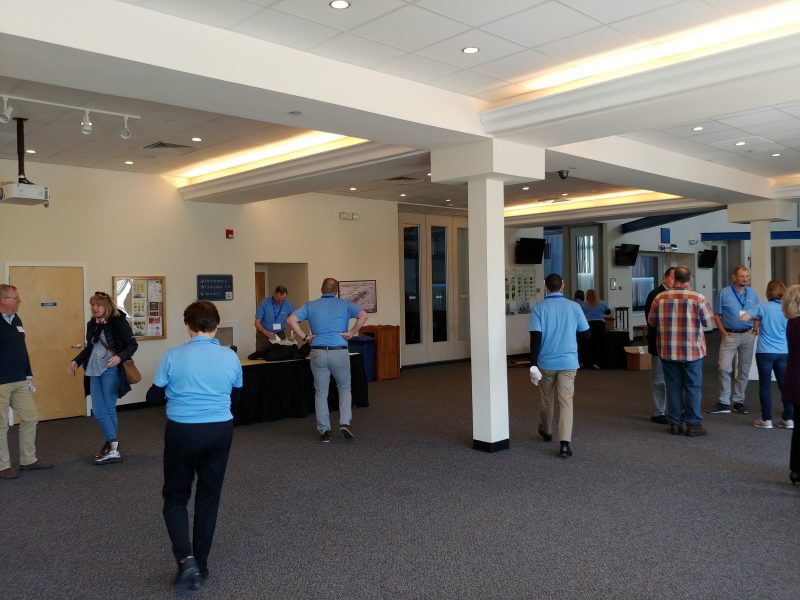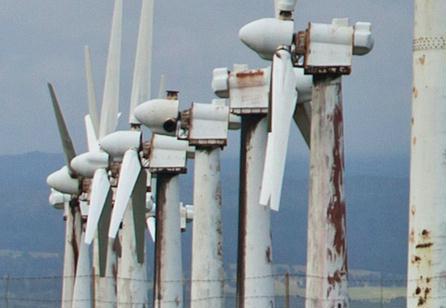
Representatives of Orsted, a Danish wind energy company held a “Community Meeting” or “Open House” at the Ocean City Tabernacle on Saturday, February 8. Their format did not permit public questions and answers. They instead asked the roughly 100 residents who attended to ask their questions in one on one conversations.
Orsted, a Danish wind energy company, is proposing a $1,600,000,000 wind energy project more than 15 miles out in the ocean. It proposes to build a large number of wind turbines and transformers east of Atlantic City and Ocean City. The project would be paid for by raising monthly electric bills. Commercial and industrial bills would go up the most.
Company representatives explained undersea cables would be built to bring the power ashore by connecting with existing cables in Ocean City or Atlantic City.
They also displayed artists renderings as to what the wind turbines would look like from the Atlantic City and Ocean City Boardwalks and beaches.
Orsted representatives also announced that as part of its bid to win the contract from NJ State government to do the work, it was funding a $15 million “Pro-NJ Grantor Trust” to “support local infrastructure investments and small, women- and minority-owned businesses that wish to become part of the offshore wind industry”. (As reported in The Sentinel of Somers Point, Linwood and Northfield on February 12.
Because the event was held at the same time as our LibertyAndProsperity.com every Saturday breakfast discussion at the Shore Diner, few of our members arrived until the event was over.
However, during the past few weeks, we did raise the following nine concerns about the project during the course of our discussions. If you have any other concerns or other helpful information about this project, please let us know. We invite you meet us at the Shore Diner 9:30 any Saturday, or contact us by email or online comment.
Many of our concerns were raised in the following two articles about wind energy that were posted online last year:
One is “48 Reasons Why Wind Power Cannot Replace Fossil Fuels” posted on February 14, 2019 at http://energyskeptic.com/2019/wind/.
The other is “Can Wind and Solar Replace Fossil Fuels?” posted on January 1, 2019 at https://wattsupwiththat.com/2019/01/01/can-wind-and-solar-replace-fossil-fuels/
NINE CONCERNS ABOUT ORSTED’S PROPOSED $1,600,000,000 WIND ENERGY PROJECT:

Source: Leonard, T. 2012. Daily Mail “Broken Down Rusting Wind Turbines in Hawaii, is this the future of Britain’s ‘wind rush’?” https://www.dailymail.co.uk/news/article-2116877/Is-future-Britains-wind-rush.html
- An electric grid must be stable and level at all times. That means it must be either fed with a steady, predictable stream of electricity or constantly adjusted. Sudden gusts of wind create too much power that would crash the grid unless the extra electricity is dumped. Sudden drops in wind cause brown or blackouts unless back-up generators burning fossil fuels instantly inject more power into the grid. Five wind turbines have been in operation in Atlantic City since 2006. Did anyone document how much of the electricity they produced was actually used, how much was dumped, and how much fossil fuel was burned backing them up? If so, who did that study and where is it available?
- Denmark is said to have a successful wind energy program. However, it is a small country that has a special relationship with Germany, its much larger neighbor. Much of Denmark’s success comes from very good deals that let it sell its extra power from too much wind to Germany at high prices, and buy what it needs at low prices when there is too little wind. Meanwhile, Germany’s wind energy program was a failure, because it could not do that. Will New Jersey’s situation be more like Denmark or more like Germany?
- Wind turbines are built with many toxic materials that cannot be recycled. How much will it cost to take them down and safely dispose of them when they stop working after 20 years? Is that cost included in the estimated project cost of $1,600,000,000 and the rate hikes to pay it?
- In 2006, the Atlantic County Utility Authority built 5 wind turbines on land next to its sewerage plant at a cost of $12.5 million, or $2.5 million each. If the ACUA spent the same $1,600,000,000 that Orsted plans to spend, the ACUA could build 640 wind turbines on land. How many wind turbines does Orsted plan to build at sea for that $1,600,000,000?
- If the project ends up costing more than the estimated $1,600,000,000 or produces less usable electricity than expected, who will pay the difference? Orsted investors? Or NJ consumers?
- If wind turbines produce cheap renewable energy, and don’t require expensive fossil fuels, why do electric rates go up every time we build more of them?
- Roughly three fourths of Denmark’s wind turbines are on land. Only one fourth are offshore. How many wind turbines are on land in New Jersey, and how many would be built offshore?
- Are winds stronger and steadier over the ocean in on land? If so, does this justify the extra risk and expense of building and maintaining wind turbines, transformers, and cables in the ocean?
- The offshore wind turbines in Denmark seem to be in sheltered bays close to shore. Will our wind turbines out more than 15 miles in open ocean be harder and more expensive to maintain and repair? Will they be more likely to be damaged or destroyed by storms and hurricanes?

